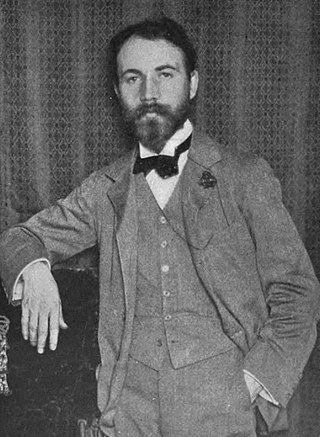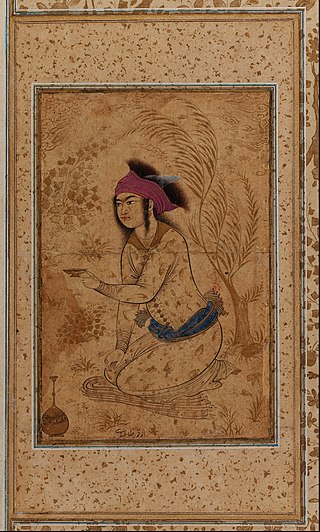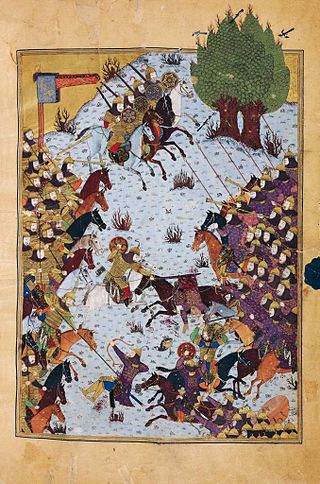Related Research Articles

The Shahnameh, also transliterated Shahnama, is a long epic poem written by the Persian poet Ferdowsi between c. 977 and 1010 CE and is the national epic of Greater Iran. Consisting of some 50,000 distichs or couplets, the Shahnameh is one of the world's longest epic poems, and the longest epic poem created by a single author. It tells mainly the mythical and to some extent the historical past of the Persian Empire from the creation of the world until the Muslim conquest in the seventh century. Iran, Azerbaijan, Afghanistan, Tajikistan and the greater region influenced by Persian culture such as Armenia, Dagestan, Georgia, Turkey, Turkmenistan and Uzbekistan celebrate this national epic.

Bernard Berenson was an American art historian specializing in the Renaissance. His book The Drawings of the Florentine Painters was an international success. His wife Mary is thought to have had a large hand in some of the writings.

The Timurid Empire was a late medieval, culturally Persianate Turco-Mongol empire that dominated Greater Iran in the early 15th century, comprising modern-day Iran, Iraq, Afghanistan, much of Central Asia, the South Caucasus, as well as parts of contemporary Pakistan, North India and Turkey. The empire was culturally hybrid, combining Turko-Mongolian and Persianate influences, with the last members of the dynasty being "regarded as ideal Perso-Islamic rulers".

JeanFouquet was a French painter and miniaturist. A master of panel painting and manuscript illumination, and the apparent inventor of the portrait miniature, he is considered one of the most important painters from the period between the late Gothic and early Renaissance. He was the first French artist to travel to Italy and experience first-hand the early Italian Renaissance.

JeanClouet (1480–1541) was a miniaturist and painter who worked in France during the High Renaissance. He was the father of François Clouet.

Reza Abbasi, also known as Aqa Reza, was the leading Persian miniaturist of the Isfahan School during the later Safavid period, spending most of his career working for Shah Abbas I. He is considered to be the last great master of the Persian miniature, best known for his single miniatures for muraqqa or albums, especially single figures of beautiful youths.

Joseph Duveen, 1st Baron Duveen, known as Sir Joseph Duveen, Baronet, between 1927 and 1933, was a British art dealer who was considered one of the most influential art dealers of all time.

Tārīkh-i Jahāngushāy or Tārīkh-i Jahāngushāy-i Juwaynī is a detailed historical account written by the Persian Ata-Malik Juvayni describing the Mongol, Hulegu Khan, and Ilkhanid conquest of Persia as well as the history of Isma'ilis. It is considered an invaluable work of Persian literature.

A Persian miniature is a small Persian painting on paper, whether a book illustration or a separate work of art intended to be kept in an album of such works called a muraqqa. The techniques are broadly comparable to the Western Medieval and Byzantine traditions of miniatures in illuminated manuscripts. Although there is an equally well-established Persian tradition of wall-painting, the survival rate and state of preservation of miniatures is better, and miniatures are much the best-known form of Persian painting in the West, and many of the most important examples are in Western, or Turkish, museums. Miniature painting became a significant genre in Persian art in the 13th century, receiving Chinese influence after the Mongol conquests, and the highest point in the tradition was reached in the 15th and 16th centuries. The tradition continued, under some Western influence, after this, and has many modern exponents. The Persian miniature was the dominant influence on other Islamic miniature traditions, principally the Ottoman miniature in Turkey, and the Mughal miniature in the Indian sub-continent.

'Abd al-Ṣamad or Khwaja 'Abd-us-Ṣamad was a 16th century painter of Persian miniatures who moved to India and became one of the founding masters of the Mughal miniature tradition, and later the holder of a number of senior administrative roles. 'Abd's career under the Mughals, from about 1550 to 1595, is relatively well documented, and a number of paintings are authorised to him from this period. From about 1572 he headed the imperial workshop of the Emperor Akbar and "it was under his guidance that Mughal style came to maturity". It has recently been contended by a leading specialist, Barbara Brend, that Samad is the same person as Mirza Ali, a Persian artist whose documented career seems to end at the same time as Abd al-Samad appears working for the Mughals.
Demotte or DeMotte may refer to:

Jāmiʿ al-Tawārīkh is a work of literature and history, produced in the Mongol Ilkhanate. Written by Rashid al-Din Hamadani at the start of the 14th century, the breadth of coverage of the work has caused it to be called "the first world history". It was in three volumes and published in Arabic and Persian versions.

A Muraqqa is an album in book form containing Islamic miniature paintings and specimens of Islamic calligraphy, normally from several different sources, and perhaps other matter. The album was popular among collectors in the Islamic world, and by the later 16th century became the predominant format for miniature painting in the Persian Safavid, Mughal and Ottoman empires, greatly affecting the direction taken by the painting traditions of the Persian miniature, Ottoman miniature and Mughal miniature. The album largely replaced the full-scale illustrated manuscript of classics of Persian poetry, which had been the typical vehicle for the finest miniature painters up to that time. The great cost and delay of commissioning a top-quality example of such a work essentially restricted them to the ruler and a handful of other great figures, who usually had to maintain a whole workshop of calligraphers, artists and other craftsmen, with a librarian to manage the whole process.
Jérôme-François Chantereau, a French painter, engraver, and art dealer who was born in Paris about 1710. Chantereau was a member of the Académie de Saint-Luc, and in his youth became a court painter to the King of Denmark.

The Physician Preparing an Elixir is a miniature on a folio from an illustrated manuscript copy, now in the Metropolitan Museum of Art in New York of De Materia Medica, a large herbal or work on the (mostly) medical uses of plants originally written by the ancient Greco-Roman physician, Pedanius Dioscorides, in the first century AD. This page of the manuscript, dated 1224 AD, is made from paper, sized 24.8 cm wide and 33.2 cm long, and is decorated by opaque watercolor, ink, and gold detailing. It is visually split into three horizontal portions from the top of the page to the bottom; the top of the page is dominated by two lines of Arabic script, followed by the image and then five more lines of text in Arabic. The writing below the image is predominantly black with the exception of one line, which is written in red ink and is therefore highlighted to the viewer. The page is usually not on display.

Persian art or Iranian art has one of the richest art heritages in world history and has been strong in many media including architecture, painting, weaving, pottery, calligraphy, metalworking and sculpture. At different times, influences from the art of neighbouring civilizations have been very important, and latterly Persian art gave and received major influences as part of the wider styles of Islamic art. This article covers the art of Persia up to 1925, and the end of the Qajar dynasty; for later art see Iranian modern and contemporary art, and for traditional crafts see arts of Iran. Rock art in Iran is its most ancient surviving art. Iranian architecture is covered at that article.

The Shahnameh of Shah Tahmasp or Houghton Shahnameh is one of the most famous illustrated manuscripts of the Shahnameh, the national epic of Greater Iran, and a high point in the art of the Persian miniature. It is probably the most fully illustrated manuscript of the text ever produced. When created, the manuscript contained 759 pages, 258 of which were miniatures. These miniatures were hand-painted by the artists of the royal workshop in Tabriz under rulers Shah Ismail I and Shah Tahmasp I. Upon its completion, the Shahnameh was gifted to Ottoman Sultan Selim II in 1568. The page size is about 48 x 32 cm, and the text written in Nastaʿlīq script of the highest quality. The manuscript was broken up in the 1970s and pages are now in a number of different collections around the world.

The Baysunghur Shahnameh is an illustrated manuscript of the Shahnameh, the national epic of Greater Iran. The work on this manuscript was started in 1426 at the order of Baysunghur Mirza, the Timurid prince, and was completed on 5 Jumada 833,. It is now in the museum of The Golestan Palace, in Tehran, Iran, and regarded as a key masterpiece of the Persian miniature.

The Great Mongol Shahnameh also known as the Demotte Shahnameh or Great Ilkhanid Shahnama, is an illustrated manuscript of the Shahnameh, the national epic of Greater Iran, probably dating to the 1330s. In its original form, which has not been recorded, it was probably planned to consist of about 280 folios with 190 illustrations, bound in two volumes, although it is thought it was never completed. It is the largest early book in the tradition of the Persian miniature, in which it is "the most magnificent manuscript of the fourteenth century", "supremely ambitious, almost awe-inspiring", and "has received almost universal acclaim for the emotional intensity, eclectic style, artistic mastery and grandeur of its illustrations".

Farangi-Sazi was a style of Persian painting that originated in Safavid Iran in the second half of the 17th century. This style of painting emerged during the reign of Shah Abbas II, but first became prominent under Shah Solayman I.
References
- "Grove", The Grove Encyclopedia of Islamic Art and Architecture, Volume 3, Editors: Jonathan Bloom, Sheila S. Blair, 2009, Oxford University Press, ISBN 019530991X, 9780195309911
- "Iranica", "Demotte ŠĀH-NĀMA", Encyclopædia Iranica, online, accessed 28 August 2016